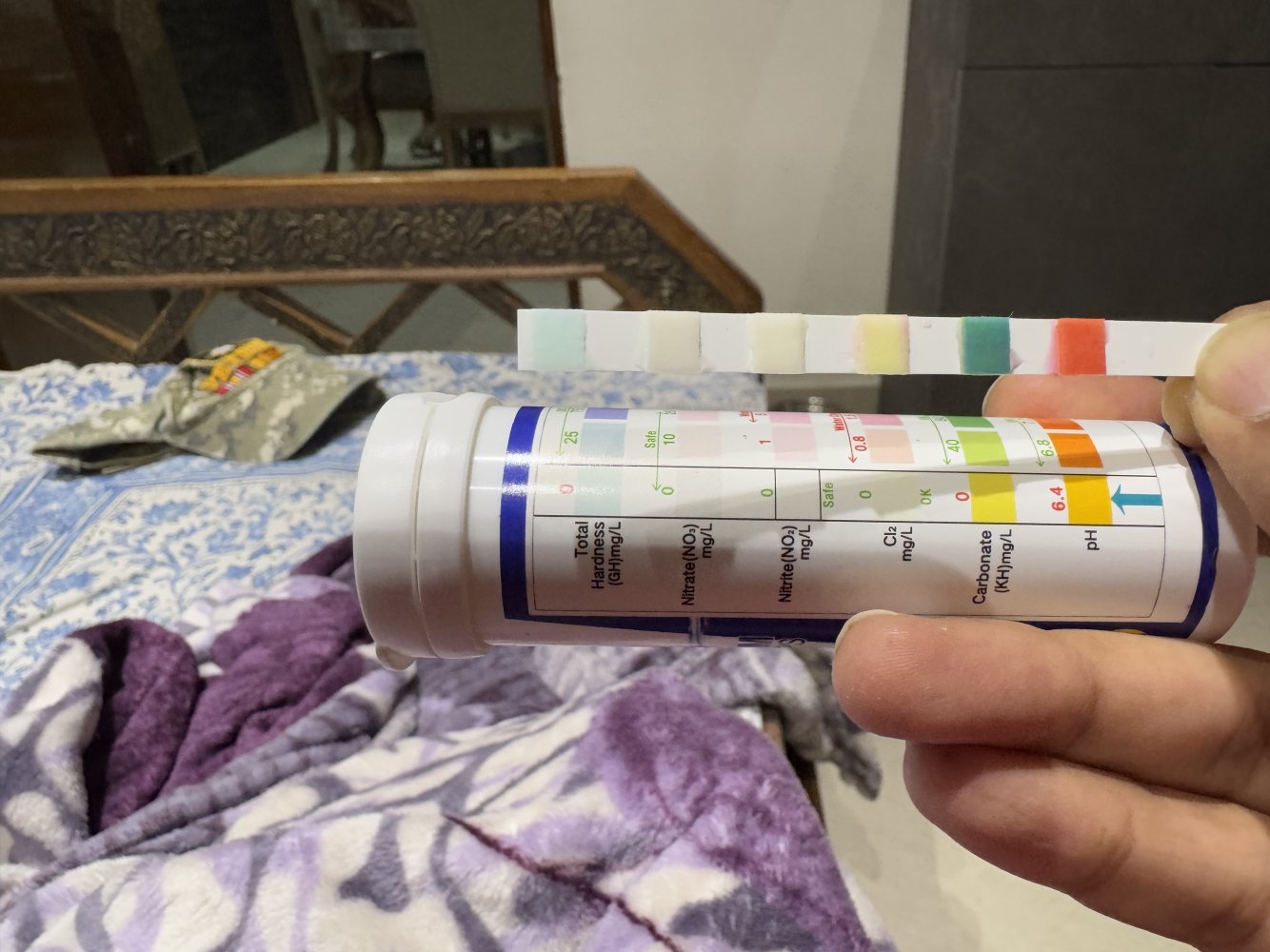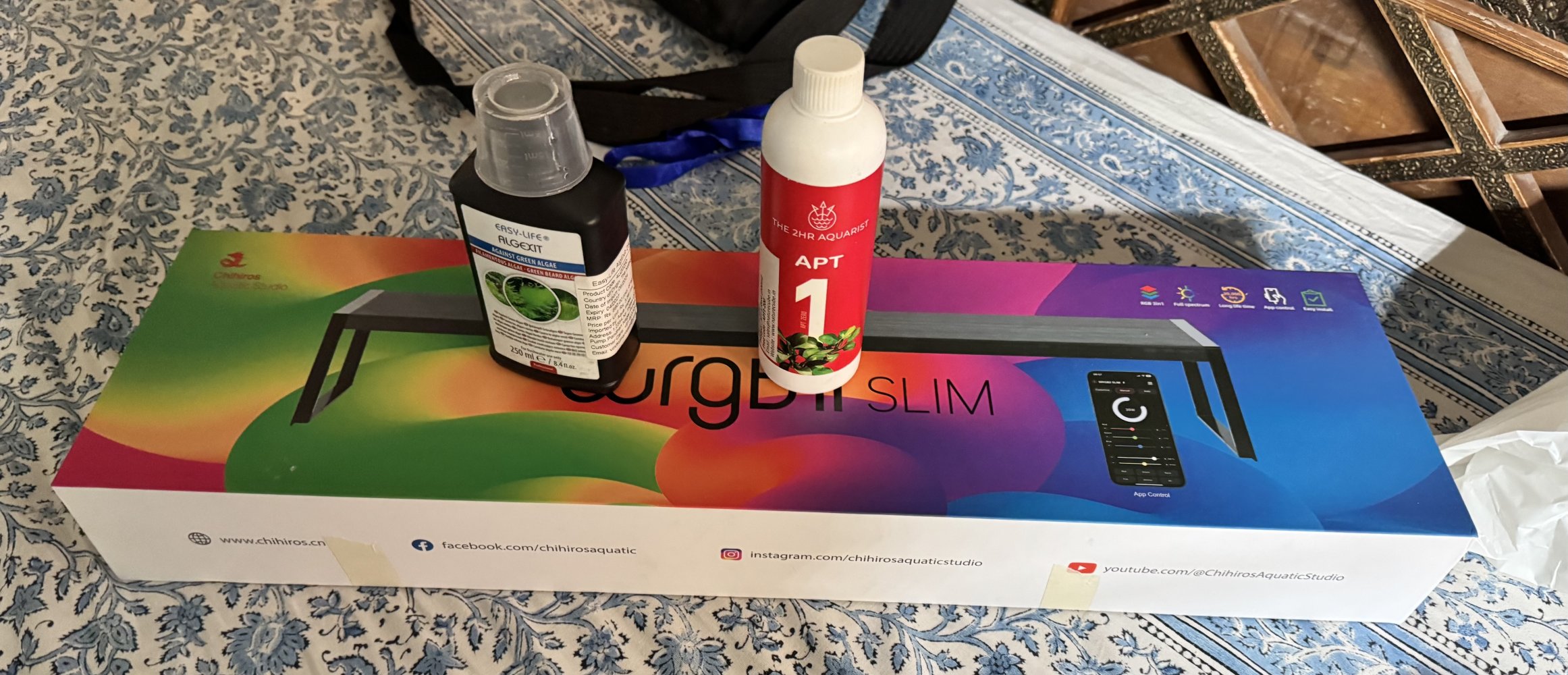Lack of experienceBut he sold it to you anyway…what does that say?
And we still don’t have a clear answer. I give up.
-
You are viewing the forum as a Guest, please login (you can use your Facebook, Twitter, Google or Microsoft account to login) or register using this link: Log in or Sign Up
You are using an out of date browser. It may not display this or other websites correctly.
You should upgrade or use an alternative browser.
You should upgrade or use an alternative browser.
My 89 Litre project.
- Thread starter maverick786us
- Start date
My comment was more about the retailer selling you something that he said you don’t really need to worry about.Lack of experience
You are running a high light, CO2 enriched tank. This means that you need to provide adequate nutrients to your plants, or algae will take over, hence my repeatedly asking what amount of NPK you are putting in. If your fertiliser bottles do not tell you, I’d throw them away and get something from Nilocg

North America's Most Trusted Aquarium Store - NilocG Aquatics Inc
NillocG Aquatics provides the best products to make your aquarium thrive, we supply high quality fertilizers, CO2 equipment, aquarium LED's, aquasoil, & more!
 nilocg.com
nilocg.com
You’re also going to need nitrates and phosphates (APT1 doesn’t have those) if you want your plants to thrive….and lots of patience….that means not tinkering and changing things all the time.I hope it turns out to be the game changer
My tank is medium stocked, so I thought nitrite and phosphate will come from fishes, shrimps and snails 🤔
I was originally going for APT 3.
I was originally going for APT 3.
You are running a high tech tank tank (CO2 and high energy light) where plants will grow quickly. It will require plant food that provides Macro and Micro nutrients. Something like NilocG all in one or APT3 or Tropica Specialised.My tank is medium stocked, so I thought nitrite and phosphate will come from fishes, shrimps and snails
Ok after
First I performed test for PH, Nitrite and Nitrate test. the result was surprising. Momentarily I thought that my tank isn't cycled so performed Ammonia test again the level of Ammonia was less. So I will get APT 3.
To my surprise, this tank has a colony of nano fishes (12, cherry barb, 8 glowlight Tetras), dozens of shrimps and snails, 3 Hillstream Loaches and 4 baby SAE. I thought these will produce enough ammonia that will be converted into nitrite and nitrate so I was afraid the extra nitrate from APT 3 can make the water toxic.


Before reading your last post, I decided to perform some test (before changing water) and the result came as a shock to me.You’re also going to need nitrates and phosphates (APT1 doesn’t have those) if you want your plants to thrive….and lots of patience….that means not tinkering and changing things all the time.
First I performed test for PH, Nitrite and Nitrate test. the result was surprising. Momentarily I thought that my tank isn't cycled so performed Ammonia test again the level of Ammonia was less. So I will get APT 3.
To my surprise, this tank has a colony of nano fishes (12, cherry barb, 8 glowlight Tetras), dozens of shrimps and snails, 3 Hillstream Loaches and 4 baby SAE. I thought these will produce enough ammonia that will be converted into nitrite and nitrate so I was afraid the extra nitrate from APT 3 can make the water toxic.


You are running a high tech tank tank (CO2 and high energy light) where plants will grow quickly. It will require plant food that provides Macro and Micro nutrients. Something like NilocG all in one or APT3 or Tropica Specialised.
After changing the light to Chiros WRG 2, in which I can increase / decrease the brightness with the help of this App, you can see the settings I am using (picture 2). I am using this Dutch ingredient to take care of algae. My dealer highly recommended me this to use it against all sorts of algae including green hair algae (picture 3). He said it's 100% safe for the live stock. But I didn't want to take chance so I used 10 ML of it



I love this light. I have yet to explore all the features of this light. The best part I liked about this light is, my nano fish cherry barb and glow light tetra. They color looked faded now looks vibrant under this light
The best way to deal with algae is to get your conditions right, rather than using chemicals:
- Correct light levels
- Correct CO2
- Regular feeding of plants with Macro and Micro
- Weekly 50% water changes
- Removal of any waste organic matter
- Cleaning all algae of glass regularly.
He will do, he made a sale.My dealer highly recommended me this to use it against all sorts of algae including green hair algae (picture 3).
Looking at the last FTS above I would recommend rather than throwing your money at multiple quick fixes, to roll your sleeves up, get your hands in the tank and do maintenance. That algae on the glass needs to be removed (followed by a water change), most of the troublesome algae we encounter in our aquariums will proliferate if not removed. The addition of your new light while making your fish and plants pop is also likely to exacerbate the problem, at least to begin with, so keep it low.
In the same photo your drop checker is blue so....
@hypnogogia above has offered you a regime that you would do well to adhere to.
Cheers!
I got APT 3. What settings should I use for the light? This isn't low? People who gave experience with Chihiros can you advice me the recommended settings?


Thank you, after reading this post I saw the review of this product in YTHe will do, he made a sale.
Looking at the last FTS above I would recommend rather than throwing your money at multiple quick fixes, to roll your sleeves up, get your hands in the tank and do maintenance. That algae on the glass needs to be removed (followed by a water change), most of the troublesome algae we encounter in our aquariums will proliferate if not removed. The addition of your new light while making your fish and plants pop is also likely to exacerbate the problem, at least to begin with, so keep it low.
In the same photo your drop checker is blue so....
@hypnogogia above has offered you a regime that you would do well to adhere to.
Cheers!
This is good but I will work on main reasons why algae started blooming at first place and work on it. I have reduced the feeding. the new light is customizable and APT 3
I bought an algae scrapper that uses razor blade. so cleaning glass no issue. Mostly I use scotch brite to clean glass. It's those small areas where my hands cannot reach, I use scraper. My biggest challenge is removing algae from moss. It demolishes the moss in some cases.The best way to deal with algae is to get your conditions right, rather than using chemicals:
- Correct light levels
- Correct CO2
- Regular feeding of plants with Macro and Micro
- Weekly 50% water changes
- Removal of any waste organic matter
- Cleaning all algae of glass regularly. Th
FrozenShivers
Member
I got APT 3. What settings should I use for the light? This isn't low? People who gave experience with Chihiros can you advise me the recommended settings?
There is no magical setting as it differs from tank to tank due to lots of variables, as advised start low and slowly increase over time if required. I would not call your settings low as they are.
This is a promotional video. In my opinion, it's completely uninteresting. The guy in the video is being paid for it.Thank you, after reading this post I saw the review of this product in YT
Did you watch until the end? At the 5 minute mark and thereafter he explains that you need to address the underlying problems and using it is not an excuse to be a lazy aquarist.Thank you, after reading this post I saw the review of this product in YT
Yes from that video I concluded that i will work on the reason that caused algae boom and use such chemical as the last resort.Did you watch until the end? At the 5 minute mark and thereafter he explains that you need to address the underlying problems and using it is not an excuse to be a lazy aquarist.
1. With the new light I reduced the light intensity
2. I was over feeding earlier by feeding the fishes twice a day now I have reduced it to once a day with same quantity and sometimes make them fast for 36 hours
3. The new fertilizer that I using as prescribed (APT all in one 3) should make the plants healthy thus reducing the amount of algae.
4 I also removed some of the mosses that harboured hairy algae and stored debris. I will soon replace those vacant spaces with Anubias and Bucephelandra
chickennublet
Member
Just briefly skimmed through this thread. There are a few things I think that need addressing.
Nothing you can do in this hobby will lead to immediate improvements. You need patience. Your tank is honestly still pretty new. From here, please pick a course of action and stick through it for like 3 or 4 weeks at least and see if things improve. If they do not, only then do you change something.
The WRGB2 Slim can get pretty bright. I agree with @FrozenShivers, I also would not consider your settings to be low. I'm using the same light as you (on a much smaller tank) and I don't believe my settings are as bright as yours but I am growing plants that are substantially more demanding. Based on the most recent photo of your tank there are hardly any plants in there that require such high levels of lighting. The plants in your tank appear to be Eleocharis sp, Hydrocotyle tripartita, bits of moss, Anubias, Bucephalandra, Java fern and like, one or two Rotala rotundifolia. Considering that your tank is still very new, you will face issues throwing that much light on a sparsely planted tank where the plant mass is almost exclusively slow growers.
Your drop checker is blue. Further, it’s blue even though you’ve appeared to have placed it directly above your CO2 diffuser. If your drop checker is still blue when CO2 bubbles are literally rising into the drop checker itself then there is either something wrong with the fluid in your drop checker, or you are barely dosing any CO2. In any case, drop checkers are not an incredibly accurate way to measure CO2 concentration. Read this, especially point 3 How to measure CO2 levels in an aquarium
You need to carry out your maintenance properly. Clean the glass regularly and don’t just change water, but siphon any bits of algae and detritus you can get along with the water. Wave your hands about in the water and siphon any bits that fly up. I also saw one of your earlier posts where you shared your concerns about cherry shrimp being sensitive to water changes. I would suggest that you do at least 50% water change once a week anyway. I regularly do at least 70% water changes and the shrimp don’t seem to care.
It is true that plants need adequate nutrition to thrive but I will have to respectfully disagree with @hypnogogia that OP absolutely needs to add nitrates and phosphates to his tank through fertilisers. I believe 2hr Aquarist advises using APT1 for tanks with little plant mass and relatively high fish loads. That said, you will not experience any downside in using APT3 instead of 1 and will probably find it beneficial instead.
All the advice that has been given already is sound. I would suggest:
1. Cleaning the glass and manually removing as much algae as you possibly can, followed by a big water change whilst removing as much detritus and waste as possible.
2. Reducing brightness by maybe a third
3. Starting CO2 two hours before your lights turn on and one hour before your lights turn off, if you aren't already doing so.
4. Measuring your CO2 in the way described in the article, which is to aim for a drop of 1 pH before CO2 starts and shortly after your lights turn on
5. Dose APT3 as directed on the bottle
6. Feeding your fish very small amounts and only once a day
7. Stop buying things that the guy at the fish shop says you need because chances are, you don't need those things (especially chemicals!)
8. Regular weekly maintenance
Nothing you can do in this hobby will lead to immediate improvements. You need patience. Your tank is honestly still pretty new. From here, please pick a course of action and stick through it for like 3 or 4 weeks at least and see if things improve. If they do not, only then do you change something.
The WRGB2 Slim can get pretty bright. I agree with @FrozenShivers, I also would not consider your settings to be low. I'm using the same light as you (on a much smaller tank) and I don't believe my settings are as bright as yours but I am growing plants that are substantially more demanding. Based on the most recent photo of your tank there are hardly any plants in there that require such high levels of lighting. The plants in your tank appear to be Eleocharis sp, Hydrocotyle tripartita, bits of moss, Anubias, Bucephalandra, Java fern and like, one or two Rotala rotundifolia. Considering that your tank is still very new, you will face issues throwing that much light on a sparsely planted tank where the plant mass is almost exclusively slow growers.
Your drop checker is blue. Further, it’s blue even though you’ve appeared to have placed it directly above your CO2 diffuser. If your drop checker is still blue when CO2 bubbles are literally rising into the drop checker itself then there is either something wrong with the fluid in your drop checker, or you are barely dosing any CO2. In any case, drop checkers are not an incredibly accurate way to measure CO2 concentration. Read this, especially point 3 How to measure CO2 levels in an aquarium
You need to carry out your maintenance properly. Clean the glass regularly and don’t just change water, but siphon any bits of algae and detritus you can get along with the water. Wave your hands about in the water and siphon any bits that fly up. I also saw one of your earlier posts where you shared your concerns about cherry shrimp being sensitive to water changes. I would suggest that you do at least 50% water change once a week anyway. I regularly do at least 70% water changes and the shrimp don’t seem to care.
It is true that plants need adequate nutrition to thrive but I will have to respectfully disagree with @hypnogogia that OP absolutely needs to add nitrates and phosphates to his tank through fertilisers. I believe 2hr Aquarist advises using APT1 for tanks with little plant mass and relatively high fish loads. That said, you will not experience any downside in using APT3 instead of 1 and will probably find it beneficial instead.
All the advice that has been given already is sound. I would suggest:
1. Cleaning the glass and manually removing as much algae as you possibly can, followed by a big water change whilst removing as much detritus and waste as possible.
2. Reducing brightness by maybe a third
3. Starting CO2 two hours before your lights turn on and one hour before your lights turn off, if you aren't already doing so.
4. Measuring your CO2 in the way described in the article, which is to aim for a drop of 1 pH before CO2 starts and shortly after your lights turn on
5. Dose APT3 as directed on the bottle
6. Feeding your fish very small amounts and only once a day
7. Stop buying things that the guy at the fish shop says you need because chances are, you don't need those things (especially chemicals!)
8. Regular weekly maintenance
Thank you. I will reduce the light further. I have some more fast growing stem plants that I will plant in the background this week. Can you recommend me tools that I can use to siphon debris on substrate and mosses or do I have to buy a turkey Baster?
chickennublet
Member
I comb my fingers through sand and plants to stir up detritus then siphon it out with a hose.Thank you. I will reduce the light further. I have some more fast growing stem plants that I will plant in the background this week. Can you recommend me tools that I can use to siphon debris on substrate and mosses or do I have to buy a turkey Baster?
For aquasoil, I would use a turkey baster (or pipette for small tanks) to blast debris into the water column whilst hovering a hose above the substrate to siphon the debris away.


